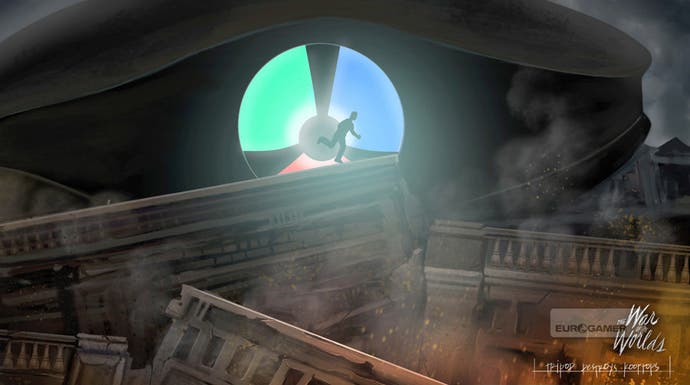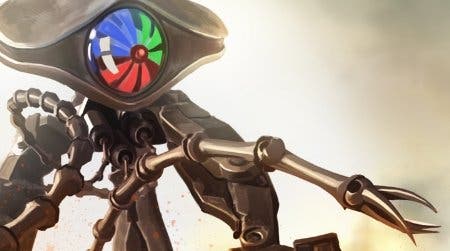The War of the Worlds Review
Global disaster.
"The street was pitted with craters and blocked with smashed vehicles, but without weapons to fight back, all we could do was run and try to keep a few paces ahead of their heat-rays."
Sir Patrick Stewart, national treasure, beloved space-faring thespian and mocker of overweight comedians reminds me for not less than the 30th time that a brilliant idea, horribly executed, will always sink lower than consistent mediocrity.
Picard's involvement with The War of the Worlds has been well-publicised in advance of Other Ocean's release of its imagining of the classic HG Wells novel. A scrolling 2D platformer that combines remarkable visual styling with a mixed bag of precision platforming, puzzle-solving and, yes, crate-stacking, this game sounds like a dream come true.
And in those early moments when the hero of the tale, Arthur Clark, awakens from unconsciousness before clawing his way through a Paddington Station left in ruins in the wake of the Martian invasion, the game blends Stewart's imposing narration with a wonderful artistic flair.

The visual style is a multi-layered parallax dream in which your middle-distance character is occasionally obscured by the frantic, escaping silhouettes of refugees, rendered large in the foreground. In the background, those dreadful Martian machines chomp gloriously at late-19th-century London. If the artists' intention was to add urgency and fraught tension in line with the unfolding story, then it's been impeccably, beautifully achieved.
Sadly, when you reach the post-introduction section of Edgware Road, this astounding blend of atmospherics, narration and visionary artwork simply falls apart, a victim to the underlying mechanics. The game never recovers.
The controls that start out as a little wobbly become not so much fussy as petulantly disobedient - and ill-suited to the increasingly difficult platforming challenges that unfold. The checkpoints - some too long, some too short - are all inconsistent and frequently buggy, often refusing to trigger at all until dozens of attempts have passed by and you've passed over the precise, meagre cluster of pixels that flags your progress.
In a frantic run that requires timed use of cover, you learn that the invading machines will periodically issue three heat-ray assaults that sweep across the screen, barbecuing anyone or anything foolish enough to remain out in the open. As well as fiddly ledge access, the buildings themselves betray a tendency to provide inconsistent cover, and a second attempt - recreated with absolute precision - can often lead to wholly random results.
"A brilliant idea, horribly executed, will always sink lower than consistent mediocrity."
There's also a thoroughly cantankerous and invisible Goldilocks ticking away in the machine, demanding that you proceed through each section of the game not too fast - and not too slow - but almost never quite right. There's little satisfaction to be had from making progress through sheer luck alone.
On one occasion, I found myself unable to go further and seemingly in the position of having to accept my fate. At this point, the natural inclination for anyone who values their time would simply be to quit the game, uninstall it and ruefully wonder just how many pints 800 Microsoft Points gets you these days. In the position of reviewer, I started again from the very beginning of the game and worked my way back through - previous frustrations and all.
As it turned out - finding myself in precisely the same situation as before - progress was ultimately made possible by disobeying the scant teachings of the game's pacing and charging headlong into what I'd clearly been taught would result in certain heat-ray death. On this occasion however, I got just a little bit further along the road before being fried. Checkpoint triggered.
Games like Super Meat Boy and Trials HD cater to an audience I count myself a gleeful member of - but they earn their place in our affections through pin-sharp controls and a stark adherence to the golden rule that underpins precision gaming: never cheat the player. That it takes so long to restart each attempt in The War of the Worlds only pours salt into the wound.
In every way that matters, The War of the Worlds fails to satisfy its presumed audience: the skill-focused gamer who wants to sink their teeth into the meatiest of challenges and make progress through nothing but their own gaming prowess.
In the process, the game also manages to take rich narration and render it an infuriating gimmick through foul play and endless, agonising repetition. Death, rewind, restart, narrate:
"The street was pitted with craters and blocked with smash-"
SHUT. UP.
And that's something you should never find yourself bellowing at Sir Patrick Stewart, national treasure, beloved space-faring thespian and mocker of overweight comedians.
The real pity is that once you've struggled through this disagreeable start, the game works harder to open up its charms, although it's still plagued by its own implementation.

What follows is a thrilling escape across the rooftops of Bayswater Road while a menacing Martian machine looms large in the near distance. The rooftops are ripped apart and crumble into fragile sections that demand death-defying leaps. In concept, it's a marvellous set-piece, but the reality was marred on my first attempt by a glitch that left me invulnerable and suspended in mid-air, twitching in animation purgatory as I floated awkwardly through the remainder of the level.
Alas, it didn't get me through the level - it bugged out, froze, and then eventually returned me to the start. A second attempt saw the frame rate crawl to a halt, reducing my success down to luck as much as anything else. But beneath the technical problems, the challenge - at odds with the previous sections - amounts to little more than running without stopping while hitting the jump button at the end of each ledge.
Later, the invading forces rain black smoke upon the city, a malevolent and intelligent gas that leaves you with the task of traversing an office building while covering vents with the boxes that litter the scene. The crates can then be used to reach a higher floor - that's if they don't choose to abandon the laws of physics after you jump, and glide, frictionless, across the floor. Both Arthur and the player are left choked.
For each beautiful and uniquely-styled level in The War of the Worlds, there is an intractable design problem that goes beyond any gamer's ability to tackle the challenges of precision platforming, timing and environmental learning with any degree of fairness.
Narrative drive makes for an odd-couple combination with trial-and-error gaming at the best of times, regardless of overworked narration or clumsy mechanics. It only leaves you pondering just how much more enjoyable, rich and satisfying the game's ambience and storytelling potential could have been, had they been applied to just about any other genre or play style.
Put simply, The War of the Worlds is a visually stunning, dreadfully fussy and cruelly unsatisfying hardcore game - one that does very little indeed to reward the near-infinite levels of patience required to get anywhere close to the value of your time or money. It takes a cherished story about man's ingenuity in the face of tyranny and leaves you hoping for nothing more than that everyone should die in the end. Tough gig.









